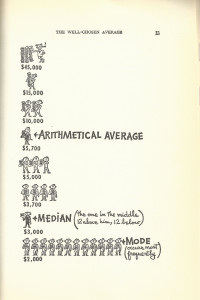 How to Lie with Statistics by Darrell Huff
How to Lie with Statistics by Darrell Huff
My rating: 5 of 5 stars
OK, first off, it isn’t normal that I give a math book 5 stars. I often find them dull, boring, and difficult to read. However, How to lie with statistics was as funny as it was informative. Duff does a good job of not only explaining what tricks people use on statistics to twist the facts, but he gives poignant examples that were just as relevant when he wrote this book as they are today. What I found most interesting is how he dissected the “logic” that uses these techniques to explain how they did it, what they trick your brain into seeing, and how you can question it effectively.
Duff talked about sample biases, which we can see in every day research. While his example was that of Yale graduates pay grades is a bit outdated, he shows how this sample represents a small number of people, and how it is most certainly a false representation based on logic, common sense, and science.
He then went on to dissect the differences between mean, median and mode, followed by inadequate samples (think sales pitch where you only ask 3 people versus more), tests that mislead and reveal nothing (like IQ tests), manipulation of graphs and scales, semi-attached figures, post hoc representations, and statistical manipulations. He did the same thing with each topic to show how you start with facts, manipulate it, and present it. Then he shows you how it’s wool covering your eyes.

The last chapter was my favourite. It tells you how to pull the wool from your eyes and argue back against it by pointing out their chicanery. Essentially it was a recap of the previous chapters, then telling you not to be afraid to call out the BS you see in the media, advertising, or politics.
Duff does all this in a tongue-in-cheek way. He pulls no punches, nor does he sugar coat things. When I read this I could easily pick out several examples of every single thing he talked about from my own environment. Lies the media tells me to say so it’s “politically correct”, lies on the magazine back advert, graph manipulation in my precious National Geographic or Time Magazine… it was a disappointment to see how pervasive it is in our society. It’s even more disappointing knowing that most people do not know what they are looking at and do not know that they are being swindled.
This is a book that everyone should read so they are more well informed about the world around them and can pull the wool from their eyes. I can say this is one book I’ll be buying for the Insanitek library, and may even force my journalists to read if they want pay raises. Yes, it’s that useful.